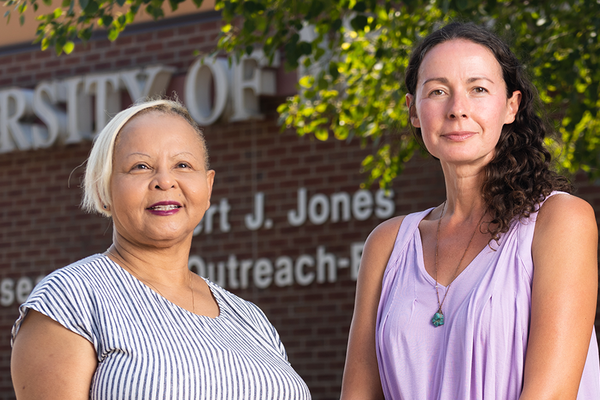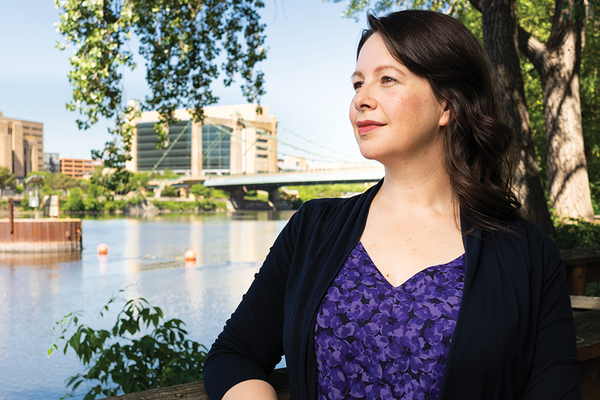Community engagement key to fostering robust results
Community-engaged research is a powerful approach for nurses
November 3, 2021
Brett Stursa
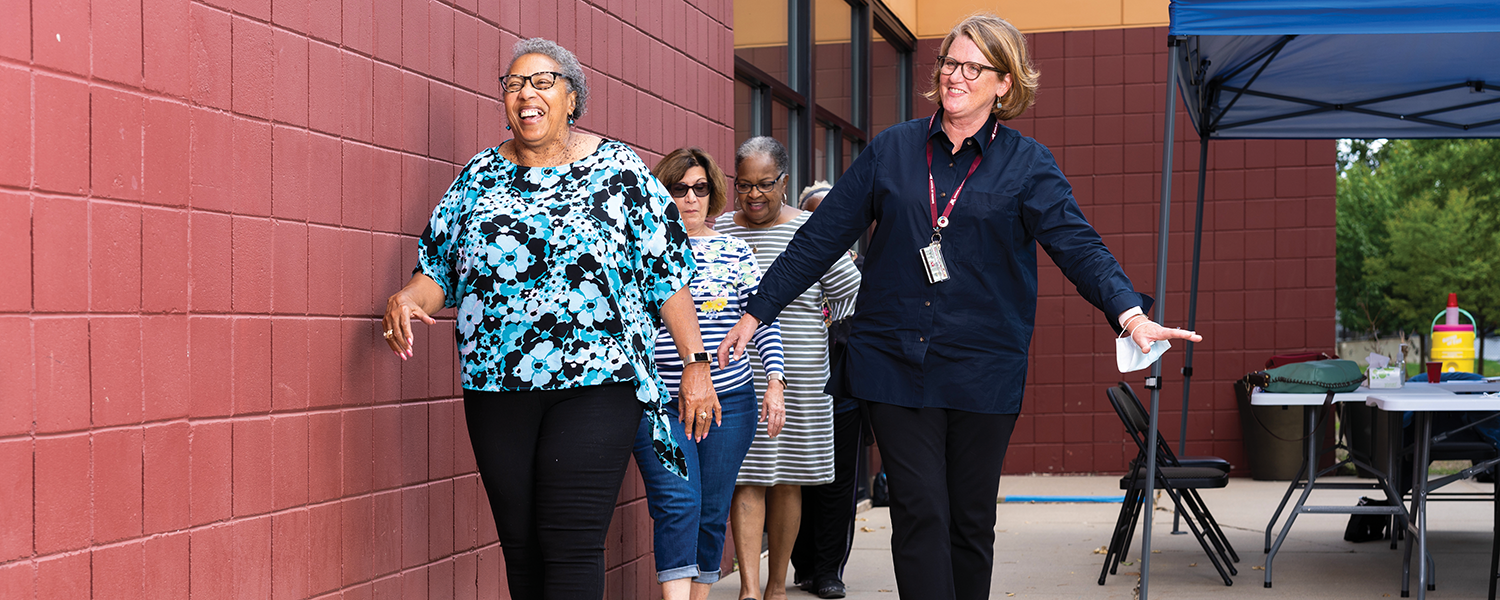
Above: Nurse researcher Siobhan McMahon practices a balance-challenging exercise (heel-toe walking) with participants in the Ready Steady study.
Behavior change doesn’t happen in the hospital or in the clinic. It happens in people’s lives, in their homes, neighborhoods and communities.
That’s a key reason why researchers at the School of Nursing routinely engage deeply with community partners during various stages of research. “We don’t think people are separate from the environments in which they live. To understand how to intervene, you need to understand the people and the contexts in which they live,” says Associate Dean for Research Diane Treat-Jacobson, PhD, RN, MSVM, FAHA, FAAN, Cora Meidl Siehl Chair in Nursing Research for Improved Care.
Treat-Jacobson, whose expertise is exercise training in patients with claudication from peripheral arterial disease (PAD), says community engagement can lead to stronger project design, implementation, and relevant and enduring findings.
“It makes the interventions more feasible and realistic, and the interventions have the potential to work better,” she says. “You gain a better understanding of the people who you’re working with, and it seems like being in touch with the community helps inform the questions that you have and then enhances your ability to answer them.”
Her recent project, Peripheral Artery Disease: Promoting Healthy Aging and Mobility in Rural Minnesota (PAD Prairie Initiative), involved building partnership with rural health care professionals to raise awareness, facilitate screenings and provide effective exercise therapy for people with PAD.
“We partnered with health care professionals to say ‘This is what our overall goal is, and what it looks like in your community is going to be determined by you,’” says Treat-Jacobson. The four-year project broadened her perspective and encouraged her to be more flexible.
“It really opened my eyes to the notion that if you don’t design something that’s going to be workable in the day-to-day busy world of peoples’ lives and a health care system, it doesn’t matter what you do, because it’s not going to take,” says Treat-Jacobson.
The investment in time and resources was appreciated by the health care professionals and community members with PAD.
“The PAD Prairie Initiative staff at the University of Minnesota have provided us with everything — plus more – than we could ever need. They have been the best resource of any in my career. It’s been above and beyond anything I expected and we have seen awesome results,” Kayla Larson, a cardiac rehab technician for Lake Region Healthcare in Fergus Falls.
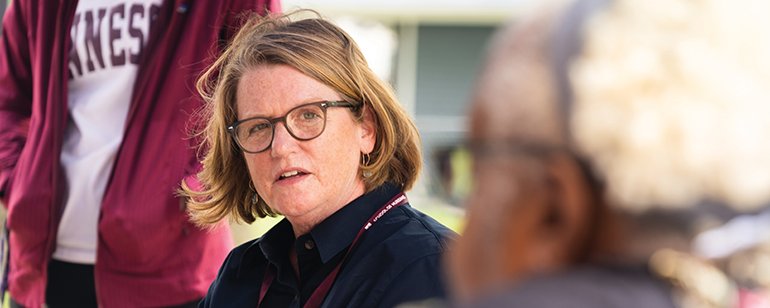
In her research focused on promoting health and wellness across diverse older adult populations with fall risk, Associate Professor Siobhan McMahon, PhD, MPH, APRN, GNP-BC, School of Nursing Foundation Research Professorship, says partnerships are essential. The resulting community-engaged research enables its design, recruitment, implementation and dissemination, and makes it possible to study factors that influence translation. Her studies examine the unique effects of different behavior change strategies, also known as health promotion strategies, on making certain physical activities, such as balance-challenging, leg-strengthening movements, part of everyday life.
“Community members have helped make decisions in all phases of this research, which ensures it is meaningful and acceptable to them,” says McMahon.
A component of the community-engaged research is her team’s commitment to mutual partnerships. This involves providing information, assistance and input to some of our partners’ work. “Our team of students and researchers have facilitated conversations and collaborative learning about health topics that are of interest to our community partners, such as balance, sleep and diabetes in more than 30 gatherings,” says McMahon.
Ultimately, McMahon sees community engagement as key to fostering research that yields better solutions to public health problems. “Because our research is community-based, participants tend to represent the population of people over 70 who live in the Twin Cities, and in turn, our conclusions are more generalizable,” she says.
Community-engaged research powerful framework for nurses
Community-engaged research is a powerful approach for many types of research nurses conduct, from health promotion to intervention research.
“Community-engaged research is important when conducting intervention research because it occurs in realistic settings—settings that are natural to participants and reflective of their everyday lives,” says McMahon. “Nurses understand that a person’s response to illness or risk is not only dependent on the way they think and what they believe, but also the resources that they have in their community context. It’s all interdependent. We are taught to consider that from the beginning of our nursing education. A person’s community context is going to affect and influence the way they respond to whatever illness or risk is in front of them. It’s just an integral part of that person and their health.”
As a public health nurse and nurse researcher, Professor Cheryl Robertson, PhD, MPH, RN, FAAN, says her work is 100% community engaged. “My work has always been community-driven, community-supported and community-led whether it be here, in other states, with other communities or across the globe,” says Robertson. “I get the privilege of being able to follow along and help put shape to it and structure in a way where we can measure whether or not it’s effective.”
She said nurses are well-suited to conduct this type of research because they know the importance of building relationships and the value of partnerships. “Nurses know the joy and skill in eliciting the story from people, because we need the story to explore how to be most effective in helping people feel better,” she says.
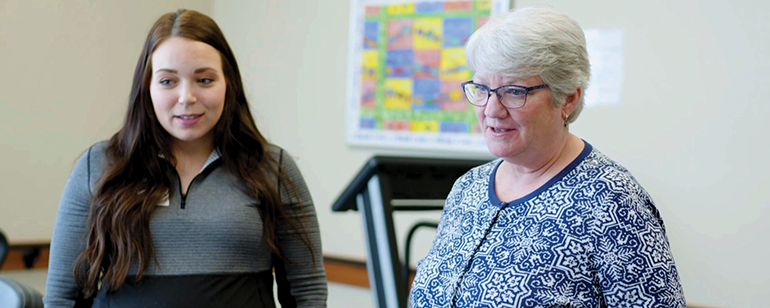
The community of researchers at the School of Nursing, specifically, and the University, more broadly, are invested in finding community-centered solutions with this research approach, she says. “The University of Minnesota does a really good job at providing the tools to conduct community-engaged research,” says Robertson, explaining that it can be a slower approach because of the time it takes to develop and build relationships. “That can be stressful when you can conduct other types of research quicker. So, that’s been recognized and University-wide, there’s support for how to strategize building a community-based program while on the tenure track.”
McMahon agrees that the University community fosters this type of research, from the Clinical and Translational Science Institute to the Office for Public Engagement. “I think our University of Minnesota has some incredible resources and orientation to the spectrum of community-engaged research. So everywhere you turn, there are experts, programs, guidelines and tools that investigators conducting community-based research can use.”
McMahon says the benefits of that support can be seen in the community. “The knowledge generated by the research is disseminated in the community in ways that bolster community-relevant resources and make a positive impact on individual and community health and wellbeing,” she says.
